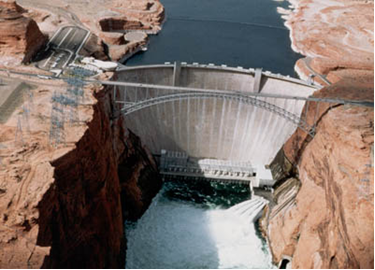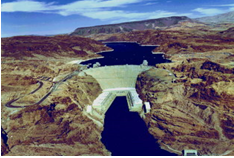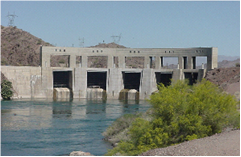Hydropower Program

Glen Canyon Dam

Hoover Dam

Davis Dam

Parker Dam
Hydroelectric power, or “hydropower”, is produced when the energy in moving water is used to turn electric turbines that generate electricity. This form of generation has been in use for many decades. The following link explains, in greater detail, what hydropower is and how it is generated https://youtu.be/tpigNNTQix8.
The Colorado River Commission of Nevada (CRCNV) is responsible for managing and protecting Nevada's allocation of hydroelectric power that is generated and marketed by the federal government. The Bureau of Reclamation (BOR), an agency under the Department of Interior, is the federal agency that owns and operates the major dams and associated powerplants on the Colorado River. Western Area Power Administration (WAPA), a federal power marketing agency under the Department of Energy, markets the power as well as distributes it over a sizable network of high voltage transmission lines. “In an average year, WAPA markets and delivers more than 25,000 gigawatt-hours of hydroelectric power. This amount represents 100 percent of the annual energy needs for about 2.3 million average American homes.”1
Nevada has an allocation of hydroelectric power from the Boulder Canyon Project (Hoover Dam), Parker-Davis Project, and the Salt Lake City Area Integrated Projects. Nevada receives approximately 24 percent of the power that is generated by the Boulder Canyon Project, 22 percent of the power that is generated by the Parker-Davis Project, and 2 percent of the power that is generated by the Salt Lake City Area Integrated Projects. The CRCNV holds long-term contracts with the federal government for the purchase of these resources. The CRCNV delivers the power it purchases to its wholesale utility contractors, full requirements contractors at the Black Mountain Industrial Complex, and various end-users including state and local governmental entities and educational institutions.
The hydropower provided by the CRCNV brings many benefits to the communities that receive it. Hydropower is provided at cost and is often the least expensive resource in our customers’ energy portfolio. It is also a clean source of power and is “renewable” in the state of Nevada, meaning that customers that are subject to the state of Nevada’s Renewable Portfolio Standard (RPS) can count it toward meeting the state’s renewable energy goals. “According to the DOE’s Hydropower Vision Report, the Nation’s hydroelectric fleet avoids about 225 million metric tons of carbon pollution in the U.S. each year, equivalent to the emissions of 42 million passenger cars.”2
In addition to being a clean source of power, hydropower contributes toward the reliability of the electric grid because its output can be ramped up and down quickly in response to electrical demand. Because it is not reliant on daily weather, it works well in conjunction with other renewable energy sources such as wind, solar, and battery storage. Finally, hydropower provides “black-start” capability to the electric grid meaning that it can provide energy to restart the electric grid following a major disruption.
The CRCNV focuses on protecting the value of our hydropower resource while recognizing that the source of this valuable resource, the Colorado River, must be managed in a way to provide other vital services such as flood control and water to meet urban and agricultural demands. The CRCNV participates in many collaborative forums with our federal partners and fellow contractors to balance the needs of all who rely on the river as a source of life-sustaining water and inexpensive energy while also acting as environmental stewards of the river. We are committed to ensuring continued long-term delivery of these reliable, clean, and inexpensive sources of energy to southern Nevada.
1Statement of Mr. Mark A. Gabriel Administrator Western Area Power Administration U.S. Department of Energy, Before the Energy and Natural Resources Committee US Senate, March 11, 2021, “Hearing on the Reliability, Resiliency, and Affordability of Electric Service.”
2ibid.